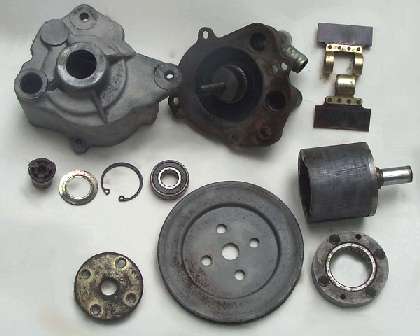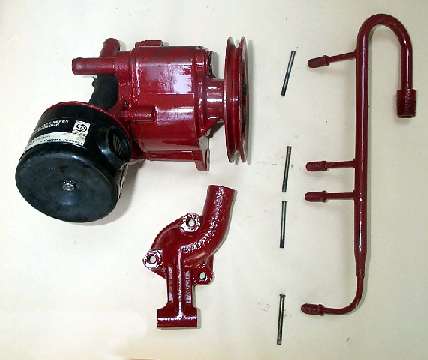Just a Simple Wrench
by Ann & Jake Snyder
 Daily Driver or Antique?
Daily Driver or Antique?
We did not at all talk about the possibility of a separation, but we knew it could happen. Not the two of us, you understand, but the three of us, which includes the MGB. We have had an MGB as a daily driver since 1971 (with an occasionally running TD for years before that, but not running frequently enough to be considered a daily driver), and our MGB seemed a fairly safe constant in our daily routine. And not that we relied on only one MGB to provide this constant feature, it was just that the ’71 roadster has the driver’s side cut off due to an interrupted welding job, and the ’72 GT needs to have the motor freshened and the passenger’s side replaced before winter. (As for the TD - well, it never was a great winter car, as we remember). That left us with the rubber-bumpered GT, which is a summer-only daily driver, and which was the subject of the pink EPA postcard. These are not pleasant notices, and there are the stories about delinquent owners who are stopped for routine checks or lighting problems, but are incarcerated due to the legal (mis?)conception that an out of specification engine emission constitutes a misdemeanor offense.
The pink postcard also came a very bad time emotionally, just a few days after the second EPA test failure with the rubber-bumpered GT. The first test was the worst we had ever had, with the test line technicians breathing blue smoke as they gave the car a fair test using the standard old-fashioned idle test. They even ran it on the treadmill for a few minutes to get it “conditioned” during the test procedure. The HC (hydrocarbons) result for the first test was 2012 ppm (parts per million), where the limit is 800. CO (carbon monoxide) was under the 8.0 percent limit. The blue smoke was the most offensive to us, but whether it accounted for the high HC is not clear. At any rate, we replaced the head, using new manifold studs and a Payen (graphite) head gasket. The smoke problem cleared up immediately, not surprising since the old head had badly chipped tops on the valve guides. The old head also had not been converted to hardened seats, and the exhaust valves were receding into the head to the extent that one had no clearance when last checked. The second EPA test was better, but still a disappointment with an HC level of 1716 ppm. An engine miss became evident and got progressively worse. The fault was traced to the new manifold studs, which had a longer portion in the middle that was not threaded than had the original studs. Consequently, when the intake manifold was bolted in place, it seemed tight when actually the four center nuts were simply running out of threads in the middle of the new studs. The increase in torque felt right, and the new gasket made everything seem tight, but the gasket compressed and leaked air into the intake in a few hundred miles. We repaired this with some really thick washers, and proceeded to set the carburetters for the third test. We did not know it at the time, but the third test is not the final chance for a car. Rather, it is the third UNSUPERVISED test that a motorist may use. All subsequent tests include under-the-hood inspections.
We used the CO probe and monitor while performing the carburetter balance and mixture adjustments. (These units now cost about a hundred dollars, and they can save thousands dollars worth of frustration. Frustration that can lead to licensing an MG as an antique vehicle to avoid the EPA tests, while also removing the MG from the daily driver roster.) We had the carburetters adjusted as well as we could, and were almost satisfied, when both of us saw the mixture needle on the CO monitor swing from the white center portion to the red rich portion, hovering finally at a air-to-fuel reading of about 12.7. This would have been okay to try for a first test, but we both felt it was a sure third test failure and another step to the dreaded antique plate status
We reviewed our options:
THE MAN at the EPA had very politely told us that he knew MGs were difficult sometimes, and remembered at least one that “had to be taken out of the area”, indicating that a waiver might not be likely. The rebuilt head had taken care of the blue smoke (and dropped the oil consumption from a full Guinness pint per tank of fuel to barely a lady’s sherry per tank), and the properly-tighten manifold had dropped missing to a minimum. But we still had the erratic air-fuel mixture to contend with. In our limited experience, this could be attributed to two items - either the throttle shaft bushings were worn enough to permit a little air to enter from time to time, or the pre-EPA SU HS4 that we had substituted for the original HIF4 carburetters were erratic by design, possibly because they did not include the temperature compensation of jet height that is incorporated in the later HIF4 type that had been removed from the car a few years ago. And as long as we were considering EPA equipment, where did that old air pump get to that we had bought a swap meet so long ago?
So we voted on a maximum effort - we needed the MGB as a daily driver, and we do not trust to the magnanimous instincts of those who monitor vehicle licenses to give us a daily pass on antique plates. Our maximum effort obviously included rebuilding the SU HIF4 carburetters, and we briefly debated whether the air pump was a frill or a necessity. In the end, we decided that the third attempt would be as full a recreation as that which the US EPA had originally blessed many years ago. We had already replaced the spark plug wires, distributor cap, rotor and points. So all we had to do on the right side of the engine was retorque the head, set the valves to 0.015 inch (hot) and set the timing (15 degrees before-top-dead-center at 1500 rpm with the vacuum advance disconnected from the intake manifold and the vacuum connection plugged). The carburetter (left side) was not really difficult either, and we rebushed the carburetter bodies, installed new throttle shafts, new jets, O-rings all around, gaskets, Grose-jets and ABD needles. (We also slipped in solid butterflies or throttle plates, and this had lead to an irritating or pleasant, depending on your mood, backfire when shifting. Oh well, stainless steel exhaust systems are supposed to last forever, and someone has to test the warranty).
The air pump was a challenge. Although there is a strip-down in the Bentley manual, we still felt terribly alone tackling the unit. After all, Hitachi built it, and the legendary close manufacturing and operational tolerances are something to fear. The case is aluminum alloy, which automatically eliminates the MG mechanic’s favorite tool, as a hammer blow to a fragile casting is the touch of destruction. The unit did yield to the gentle might of gear pullers and the 12-ton hydraulic press. (Lacking the press, we would have had to resort to a hydraulic jack and the frame of a neighbor’s SUV). See the photo for the parts laid out prior to reassembly. As it turned out, all that was needed for immediate service was to thoroughly clean parts, grease the bearings, and reassemble the unit. The front bearing looked relatively bad, but the rust was easily washed out with solvent, and the balls and races were sound and not pitted. But we will replace the front bearing as soon as feasible. Belts are easy to get, though the filter had to be ordered from a regular MG parts vendor. There are only a few parts in the air induction system: The thermostat housing with bracket, the air pump, the back-pressure valve and the air rail. These are laid out in the photo. The rest of the original installation has to do with controlling backfiring and crankcase emissions, and is not really relevant to a dedicated effort to pass the EPA test. (Sorry, clean air-lovers, but this is the operational truth).

The air pump components, ready to be lubricated, assembled & painted.
So the third test came more abruptly than we had imagined. We thought the rules said we could purchase a “voluntary” test for $25, and save our third test when we were certain everything was right. But the administrators of the test, who are really contractors working for the EPA, and who must follow every rule they are given or find themselves in contractual default, advised us that the rules really meant that the first three tests were “unsupervised”, but that if the car failed the third test, someone would inspect under the bonnet and help us determine what pollution equipment was necessary to pass the inspection. Yes, indeed, and you-betcha, this is just what we were trying to avoid. Even to the point of replacing some of the pollution equipment that we full well knew had been consigned to a dumpster many years before we even bought the GT.
The results of the third test were astounding to us. HC came in at 82 PPM (limit 800 PPM), and CO was 2.2 % (limit 8.0). Besides feeling fortunate that all three of us were still together, we immediately asked what the problem was with all the antiques that have been converted from daily drivers just to slip by the emissions test. After all, our rubber-bumpered GT, which is titled as a 1974 vehicle, easily passed the specification for the 1980 model year. All it took was routine maintenance parts (and the rebuilt head and rebuilt carburetters definitely are included in this list), and replacing some of the pollution equipment (the air pump and associated plumbing) that should never have been removed in the first place.
The following is from “A Guide to Illinois Vehicle Emissions Inspection Program”, the full text of which can be downloaded from http://www.epa.state.il.us/. There are many interesting things here, and it is a good idea to check the advice you may have gotten over a cold one at natter ‘n’ noggin against the original. It is our observation that the use of the term “cutpoints” could be better stated if one wished to appear user-friendly.
IDLE CUTPOINTS
Weight Class 1 - passenger vehicles
Model Year HC CO CO + CO2
1980 300 ppm 3.0% 6.0%
1978 - 1979 600 ppm 6.0% 6.0%
1975 - 1977 700 ppm 7.0% 6.0%
1972 - 1974 800 ppm 8.0% 6.0%
1968 - 1971 900 ppm 9.0% 6.0%
Given our experience, no one really has a reason to change their driver into an antique. And so we cannot help but wonder, “Could it be that the real antique is behind the steering wheel”?

The main components of the air induction system. The air-rail turned out to fit a Midget, and a new one was ordered for the MGB.
|




